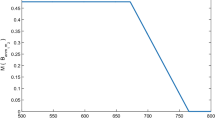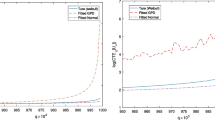Abstract
Risk processes with rare dependent claims are studied. Problems of estimation of the small probability of bankruptcy and selection of an optimal portfolio of insurance contracts are considered. The Monte Carlo method and stochastic optimization technique are applied for their solution.
Similar content being viewed by others
REFERENCES
“Climate change and increase in loss trends persist,” Press Release,Munich Re, 15. 03. 1999.
R. U. Ayres, “Complexity, reliability, and design: manufacturing implications,” Working paper WP-89–9, Int. Inst. Appl. Syst. Analysis, Laxenburg (Austria) (1989).
K. J. Arrow, “The theory of risk-bearing: small and great risks,” J. Risk Uncert., No. 12, 103–111 (1996).
J. M. Stone, “A theory of capacity and the insurance of catastrophe risk (Parts 1 and 2),” J. Risk Uncert., No. 40, 231–244; 339–355 (1973).
J. D. Cummins andN. Doherty, “Can insurers pay for the ‘Big One’? Measuring the capacity of an insurance market to respond to catastrophic losses,” Working paper, Wharton Risk Management and Decision Process Center, Univ. of Pennsylvania (1996).
W. Dong,H. Shah, andW. Wong, “A rational approach to pricing of catastrophe insurance,” J. Risk Uncert., No. 12, 201–219 (1996).
M. S. Scholes, “Global financial markets, derivatives, and systemic risk,” J. Risk Uncert., No. 12, 271–287 (1996).
C. D. Daykin,T. Pentikainen, andM. Pesonen, Practical Risk Theory for Actuaries: Monographs on Statistics and Applied Probability, Chapman and Hall, London-New York (1984).
K. Borch, The Mathematical Theory of Insurance, Lexington Books, Lexington (1974).
The Impact of Catastrophes on Property Insurance, Insurance Service Office, New York (1994).
G. Walker, “Current developments in catastrophe modeling,” in: N. R. Britton andJ. Oliver (eds.), Financial Risks Management for Natural Catastrophes, Griffith Univ., Brisbane (1997), pp. 17–35.
Y. M. Ermoliev,T. Y. Ermolieva,G. J. MacDonald, andV. I. Norkin, “Optimization of catastrophic risk portfolios,” in: M. Bonilla et al. (eds.), Papers and Proc. of 24th Meeting of Euro Working Group on Financial Modeling, Univ. de Valencia (1999), pp. 251–269 (IIASA Interim Report IR-98–056. Web: http://www.iiasa.ac.at).
T. Ermolieva,Yu. Ermoliev, andV. Norkin, “Spatial stochastic model for optimization capacity of insurance networks under dependent catastrophic risks: numerical experiments,” Interim Report IR-97–028, Laxenburg (Austria): Int. Inst. for Appl. Syst. Analysis (1997).
T. Ermolieva, “The design of optimal insurance decisions in the presence of catastrophic risks,” Interim Report IR-97–068, Int. Inst. for Appl. Syst. Analysis, Laxenburg (Austria) (1997).
Y. M. Ermoliev,T. Y. Ermolieva,G. J. MacDonald, andV. I. Norkin, “Insurability of catastrophic risks: the stochastic optimization model,” Optimization, 47 251–265 (2000).
V. I. Norkin, “On modeling spatial, temporal, and magnitude aspects in insuring cataclysmic events,” Theory Stochastic Processes, 5(21) No. 1–2, 98–110 (1999).
H. Buhlmann, Mathematical Models in Risk Theory, Springer-Verlag, New York (1970).
M. M. Leonenko,Yu. S. Mishura,V. M. Parkhomenko, andM. J. Yadrenko, Probability-Theoretic and Statistical Methods in Econometry and Financial Mathematics [in Ukrainian], Informtekhnika, Kiev (1995).
P. Embrechts,C. Kluppelberg, andT. Mikosch, Modelling Extremal Events for Insurance and Finance, Springer, Berlin (1997).
A. Consinglio andS. Zenious, “Designing portfolios of financial products via integrated simulation and optimization models,” Revised Report 96–05, Univ. of Cyprus (1998).
Yu. M. Ermoliev andR. J.-B. Wets (eds.), Numerical Techniques for Stochastic Optimization, Springer, Berlin (1988).
A. Prekopa, Stochastic Programming, Kluwer, Dordrecht (1995).
Yu. M. Ermoliev, Methods of Stochastic Programming [in Russian], Nauka, Moscow (1976).
E. Raik, “Qualitative studies in problems of nonlinear stochastic programming,” Izv. AN Est. SSR, Fiz. Mat., 20 No. 1, 8–14 (1971).
V. I. Arnold, Theory of Catastrophes [Russian translation], Nauka, Moscow (1969).
E. J. Henley andH. Kumamoto, Reliability of Engineering Systems and Risk Estimation [Russian translation], Mashinostroenie, Moscow (1984).
M. I. Zheleznyak, “Mathematical models of radionuclide migration in a cascade of water basins,” in: Systems Analysis and Methods of Mathematical Simulation in Ecology [in Russian], V. M. Glushkov Inst. of Cybernetics, Nat. Acad. Sci. Ukr. SSR, Kiev (1990), pp. 66–72.
M. Zheleznyak,R. Demchenko,S. Khursin et al., “Mathematical modeling of radionuclide dispersion in the Pripyat-Dnieper aquatic system after the Chernobyl accident,” The Science of the Total Environment, 112 89–114 (1992).
N. G. Gusev andV. A. Belyaev, Radioactive Discharge in the Biosphere (A Reference Book), 2nd ed., Energoatomizdat, Moscow (1991).
V. S. Mikhalevich,V. L. Volkovich, andN. N. Bychenok, “Problems of modeling and control of region protection in extreme situations,” Upr. Sist. Mash., No. 8, 3–12 (1991).
V. G. Gitis,E. N. Petrova, andS. A. Pirogov, “Catastrophe chains: hazard assessment,” Natural Hazards, No. 10, 117–121 (1994).
V. S. Mikhalevich,P. S. Knopov, andA. N. Golodnikov, “Mathematical models and methods of risk assessment in ecologically hazardous industries,” Kibern. Sist. Anal., No. 2, 121–139 (1994).
Y. M. Ermoliev,T. Y. Ermolieva,G. J. MacDonald,V. I. Norkin et al., “A system approach to management of catastrophic risk,” Eur. J. Oper. Res., 122 452–460 (2000).
I. V. Sergienko,V. M. Yanenko, andK. L. Atoev, “Conceptual framework for managing the risk of ecological, technogenic, and sociogenic disasters,” Kibern. Sist. Anal., No. 2, 65–86 (1997).
B. Digas, “Generators of seismic events and losses: scenario-based insurance optimization,” Interim Report IR-98–079, Int. Inst. for Appl. Syst. Analysis, Laxenburg (Austria) (1998) (Web: http://www.iiasa.ac.at ).
M. Brown,H. Solomon, andM. A. Stephens, “Monte Carlo simulation of the renewal function,” J. Appl. Probab., No. 18, 426–434 (1981).
V. D. Shpak, “Estimation of probability of cutoff of a renewal process during a fixed time by statistical simulation,” Kibernetika, No. 1, 75–79 (1983).
A. N. Nakonechnyi, “Monte Carlo estimate of the probability of ruin in a compound Poisson model of risk theory,” Kibern. Sist. Anal., No. 6, 160–162 (1995).
A. N. Nakonechnyi, “Refining the exponential asymptotic expansion for the distribution function of a sum of a random number of nonnegative random variables,” Kibern. Sist. Anal., No. 1, 112–121 (1997).
A. N. Nakonechnyi, “Optimization of risk processes,” Kibern. Sist. Anal., No. 5, 42–48, (1996).
V. S. Mikhalevich,A. M. Gupal, andV. I. Norkin, Methods of Nonconvex Optimization [in Russian], Nauka, Moscow (1987).
Yu. M. Ermoliev,V. I. Norkin, andR. J-B. Wets, “The minimization of semicontinuous functions: mollifier subgradients,” SIAM J. Contr. Opt., No. 1, 149–167 (1995).
Yu. M. Ermol'ev andV. I. Norkin, “Stochastic generalized gradient method for nonconvex nonsmooth stochastic optimization,” Kibern. Sist. Anal., No. 2, 50–71 (1998).
A. S. Nemirovskii andB. D. Yudin, Complexity of Problems and Efficiency of Optimization Methods [in Russian], Nauka, Moscow (1979).
Author information
Authors and Affiliations
Rights and permissions
About this article
Cite this article
Ermol'yev, Y.M., Ermol'yeva, T.Y., McDonald, G. et al. Problems on Insurance of Catastrophic Risks. Cybernetics and Systems Analysis 37, 220–234 (2001). https://doi.org/10.1023/A:1016798903215
Issue Date:
DOI: https://doi.org/10.1023/A:1016798903215




